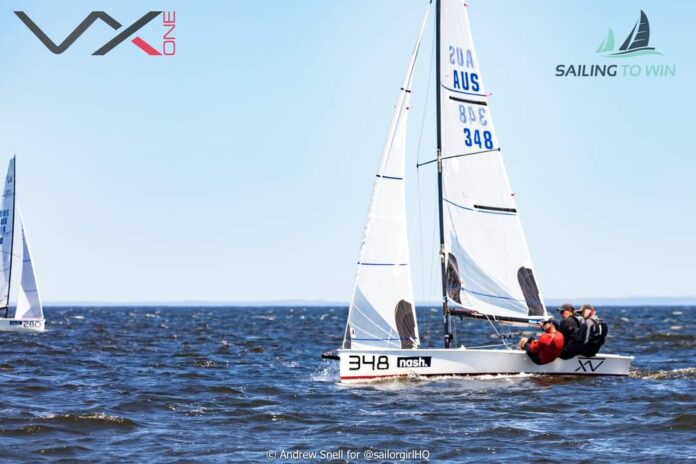

To steer fast, telltales are an excellent guide for steering in the groove but are by no means the only indicator the helmsperson uses.
STEERING UPWIND
Jib Telltales
The position of the windward telltales gives a clear idea of whether you are slightly pinching, slightly footing, or sailing at a normal upwind angle. If you’re only watching the lower telltales, you may be misled if they are breaking differently from those at the top part of the sail.
Most sailors use these as their primary “go-to” when sailing upwind but you shouldn’t depend on these as your single source of information.
- Bow Down Speed Building Mode – Leeward telltale dances windward Telltale streams straight back.
- Max Speed Mode – Bothe telltale stream straight back.
- Pointing Mode – Leeward telltale streams aft, Windward telltale dances between straight back and 45 degrees Upwards.
- Pinching Mode – Leeward telltale streams aft and windward telltale stands straight up.
Angle of Heel
A good helmsperson finds the angle of heel that feels fast and then steers to maintain that angle of heel. A combination of weather helm and watching the angle that the forestay makes with the horizon are used by the steerer if instruments are not available.
Heel angle is another way to gauge how close you are sailing to the wind; the higher you head, the less you heel, and vice versa.
Instruments
If your boat has instruments, your priority should be to post target speeds for each wind velocity and place within easy sight of the helmsperson.
Instruments should be placed where all crew members can see them. Placement should be such that the helmsperson can watch them, the telltale, the waves and the angle of heel simultaneously.
Look Out Of The Boat
If you are sailing on a boat with several crew, have someone tasked with the job of calling, puffs, waves and lulls. In a dinghy or small keelboat that job generally falls to the skipper.
The steering technique depends on how you’re moving relative to other boats. Have one crewmember give continuous readouts of speed and height compared to boats around you. This helps you to know whether you should steer higher or lower.
If there is a problem, ask for feedback on what the other boat is doing. Often a slight change in steering technique will make a difference.
Practice and Experience
Time in the boat is often the best way to learn how to steer fast.
STEERING DOWNWIND
Finding a groove downwind is usually much harder than upwind.
You don’t have the positive feel of weather helm, and it’s tough to settle in on a heading where the boat feels like it is effortlessly making its best VMG downwind.
Fortunately, there are a few guides you can use.
Course To The Mark
The shortest distance between any two points is a straight line, so you can often steer straight for the next mark, and trim your sails to match. This is particularly true for symmetrical boats or single sailboats. Not so for assymmetricals.
Just be careful not to get so fixed on one heading that you ignore changes in the wind and other variables.
Polars and Target Speeds
These are just as important for steering on a run as they are on a beat.
It is helpful to create a chart that gives your optimal wind angle and boatspeed for each true wind speed and then place it where it is easily seen.
When you find the angle your boat likes, steer up and down to maintain good pressure in the sails. With an asymmetrical kite, maintain a curl in the luff. This will ensure that the trailing edge is not bound up and acting like a handbrake.
Adjust the pole on a symmetrical spinnaker as you change the steering angle to take advantage of wind shifts or changes in pressure.
Feel
The downwind groove is usually “mushy,” so it takes extra awareness to know when you are there.
Second, you can’t read the wind on the water as easily because you are facing away from it.
Third, the wind you feel (apparent wind) is less when you’re sailing downwind, so it’s harder to feel on your body.
A Final Suggestion
Keep the rudder as still as possible when steering downwind. This is a change from going upwind, where the rudder provides lift and can help you steer around waves.
When you’re steering downwind, the main result of rudder movement is increased turbulence and drag (except when steering to catch waves in surfing conditions), so use your weight and sails to neutralize the helm.

